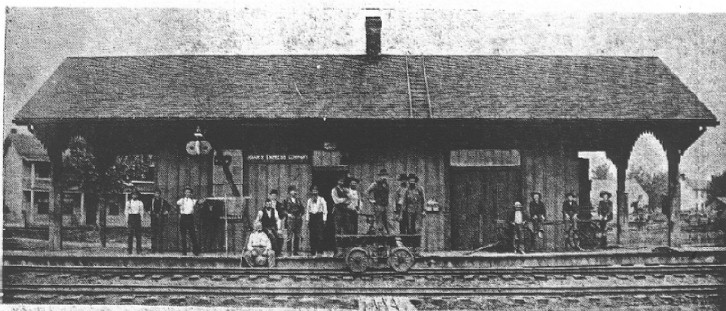

Train
Time
by Russell Pemberton
(Four photos here! Slow to load, but worth it.)


Photo submitted by Cordah
Robinson. Thanks!
McLeansboro Depot (on main track) in early days.
From:
Goshen Trails; April, 1969; Vol. 5, #2; p. 6
Printed by permission.
![]()
|
IMAGINE A PLACE in town where many, many persons congregate each day for reasons of business and recreation. As late as the 1920's, this was the picture at the local railroad station. This same was repeated in most villages and towns during that period. During the day at the local station, four trains came in from each direction each day, plus four trips up and down the Shawnee Branch. Of course there were freight trains, including the "locals"-- one of which came from the west and east. The "locals" brought in all the freight that was used as highways, as highways were not made. The usual occurrence each day was for passengers to be waiting to make trips. The mail and express trucks were awaiting their shipments to come in and the taxi met each train to transport passengers to their home or other destination. In the freight area, at least three draymen were there to pick up and deliver goods to the local merchants. If one had nothing pressing for their time, he might just go to the station to watch the activity. Some youngsters, who would be known as delinquents if this happened today, would be buzzing around trying to harass everyone possible. At one time the fad was to cut fruit jar rubbers into segments and to shoot them with rubber band, the target being the back of someone's neck. This would raise quite a welt and would be very painful. The train scheduled to go to Shawneetown sat there waiting for the train to come in from St. Louis. During the "rubber band" invasion, passengers sitting with the windows open were in danger of getting shot. Finally, to stop this, the local authorities were called on the scene. To get an idea as to how many dray wagons went from the station to the business district, take a drive on Broadway between Pearl and Washington Streets. After all the intervening years, this stretch of pavement still has a cobble stone effect. Also Pearl Street from Walker Street (this is the one that parallels the railroad) to Market Street. This will also give the cobble stone effect. Perhaps some time these streets will be blacktopped which will hide another landmark. At periodic intervals, the railroad company would send a paint gang to paint the station building. This would brighten up the scene. Have you been to the local station lately? Have you watched the remaining passenger train come in and looked at the make up of this train? Eventually, the station building in small villages and towns will all be gone. Actually, many of them have already been removed. These stations are rapidly approaching the status of the stagecoach posts that were the predecessors of the railroad stations. The much heralded generation gap is most evident in the area of the railroad station and by the time another generation rolls around, these stations and their activities will only be memories to the older residents. |
![]()

Depot of the L&N Railroad in Dahlgren (abt 1890)

Dahlgren Depot Today
Hamilton Co., IL
![]() Click
here to view Hamilton County Railroad Gang!
Click
here to view Hamilton County Railroad Gang!
![]() Back
to Hamilton County
Back
to Hamilton County ![]() Back
to Hamilton County Miscellaneous
Back
to Hamilton County Miscellaneous